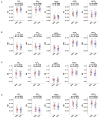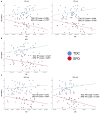Altered Cerebellar White Matter in Sensory Processing Dysfunction Is Associated With Impaired Multisensory Integration and Attention
- PMID: 33613368
- PMCID: PMC7888341
- DOI: 10.3389/fpsyg.2020.618436
Altered Cerebellar White Matter in Sensory Processing Dysfunction Is Associated With Impaired Multisensory Integration and Attention
Abstract
Sensory processing dysfunction (SPD) is characterized by a behaviorally observed difference in the response to sensory information from the environment. While the cerebellum is involved in normal sensory processing, it has not yet been examined in SPD. Diffusion tensor imaging scans of children with SPD (n = 42) and typically developing controls (TDC; n = 39) were compared for fractional anisotropy (FA), mean diffusivity (MD), radial diffusivity (RD), and axial diffusivity (AD) across the following cerebellar tracts: the middle cerebellar peduncles (MCP), superior cerebellar peduncles (SCP), and cerebral peduncles (CP). Compared to TDC, children with SPD show reduced microstructural integrity of the SCP and MCP, characterized by reduced FA and increased MD and RD, which correlates with abnormal auditory behavior, multisensory integration, and attention, but not tactile behavior or direct measures of auditory discrimination. In contradistinction, decreased CP microstructural integrity in SPD correlates with abnormal tactile and auditory behavior and direct measures of auditory discrimination, but not multisensory integration or attention. Hence, altered cerebellar white matter organization is associated with complex sensory behavior and attention in SPD, which prompts further consideration of diagnostic measures and treatments to better serve affected individuals.
Keywords: cerebellum; connectivity; diffusion tensor imaging; fractional anisotropy; neurodevelopmental disorders; sensory processing; white matter.
Copyright © 2021 Narayan, Rowe, Palacios, Wren-Jarvis, Bourla, Gerdes, Brandes-Aitken, Desai, Marco and Mukherjee.
Conflict of interest statement
MR, MG, and EM were employed by Cortica Healthcare. The remaining authors declare that the research was conducted in the absence of any commercial or financial relationships that could be construed as a potential conflict of interest.
Figures







References
-
- Ailion A. S., King T. Z., Roberts S. R., Tang B., Turner J. A., Conway C. M., et al. . (2020). Double dissociation of auditory attention span and visual attention in long-term survivors of childhood cerebellar tumor: a deterministic tractography study of the cerebellar-frontal and the superior longitudinal fasciculus pathways. J. Int. Neuropsychol. Soc. 26, 939–953. 10.1017/S1355617720000417 - DOI - PubMed
-
- American Psychiatric Association (2013). Diagnostic and Statistical Manual of Mental Disorders: DSM-5. Arlington, VA: American Psychiatric Association; 10.1176/appi.books.9780890425596 - DOI
Grants and funding
LinkOut - more resources
Full Text Sources
Other Literature Sources
Miscellaneous

